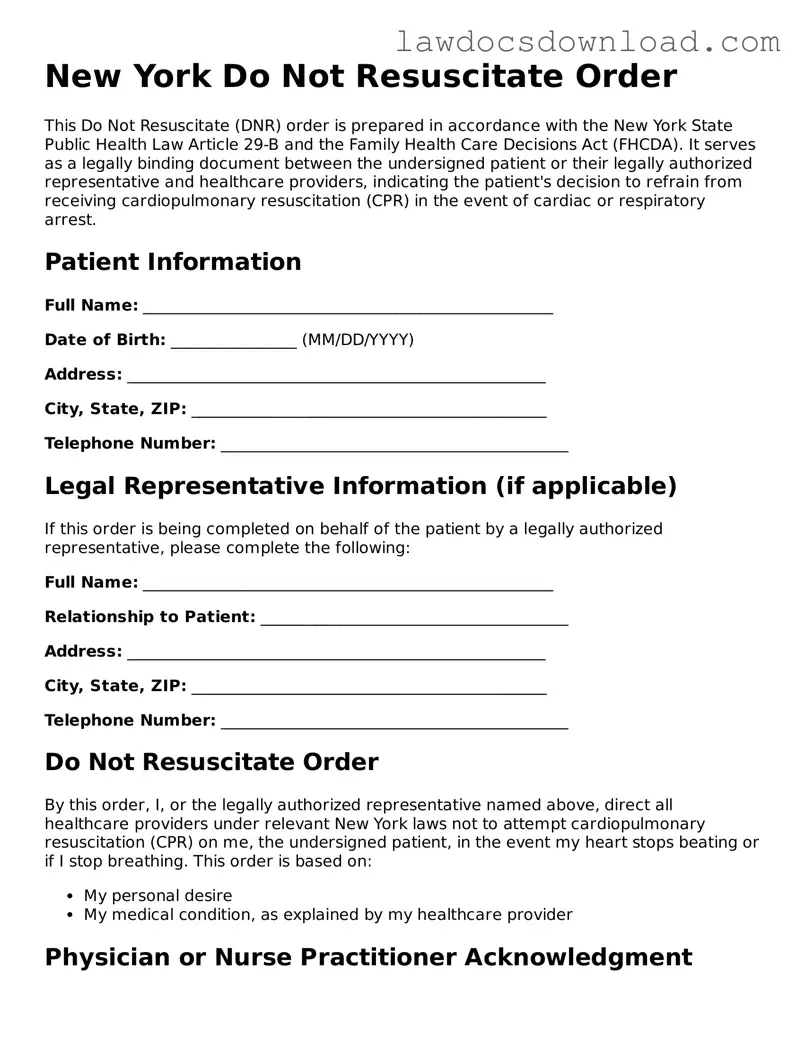New York Do Not Resuscitate Order
This Do Not Resuscitate (DNR) order is prepared in accordance with the New York State Public Health Law Article 29-B and the Family Health Care Decisions Act (FHCDA). It serves as a legally binding document between the undersigned patient or their legally authorized representative and healthcare providers, indicating the patient's decision to refrain from receiving cardiopulmonary resuscitation (CPR) in the event of cardiac or respiratory arrest.
Patient Information
Full Name: ____________________________________________________
Date of Birth: ________________ (MM/DD/YYYY)
Address: _____________________________________________________
City, State, ZIP: _____________________________________________
Telephone Number: ____________________________________________
Legal Representative Information (if applicable)
If this order is being completed on behalf of the patient by a legally authorized representative, please complete the following:
Full Name: ____________________________________________________
Relationship to Patient: _______________________________________
Address: _____________________________________________________
City, State, ZIP: _____________________________________________
Telephone Number: ____________________________________________
Do Not Resuscitate Order
By this order, I, or the legally authorized representative named above, direct all healthcare providers under relevant New York laws not to attempt cardiopulmonary resuscitation (CPR) on me, the undersigned patient, in the event my heart stops beating or if I stop breathing. This order is based on:
- My personal desire
- My medical condition, as explained by my healthcare provider
Physician or Nurse Practitioner Acknowledgment
I, the undersigned physician or nurse practitioner, certify that the patient or their legally authorized representative has discussed with me the ramifications of a Do Not Resuscitate (DNR) order. The patient, or their representative, has made an informed decision regarding the withholding of CPR. In compliance with the New York State laws, I have accordingly indicated this order in the patient’s medical record.
Physician/Nurse Practitioner Name: _______________________________
Licence Number: _____________________________________________
Signature: ___________________________ Date: _____________
Patient/Legal Representative Acknowledgment
I acknowledge that I have fully understood the nature of a Do Not Resuscitate (DNR) order, the procedures involved, and the potential consequences of this decision. I have had the opportunity to ask questions and discuss my concerns, and my decision is made freely and without any undue influence.
Signature of Patient or Legal Representative: _________________________
Date: ________________ (MM/DD/YYYY)
This document is binding across New York State and will be honored by all healthcare providers, including emergency medical personnel, in accordance with state laws. It should be reviewed periodically, especially if the patient's medical condition changes. Revisions or revocation of this order must be discussed with a healthcare provider and documented as required by New York law.
